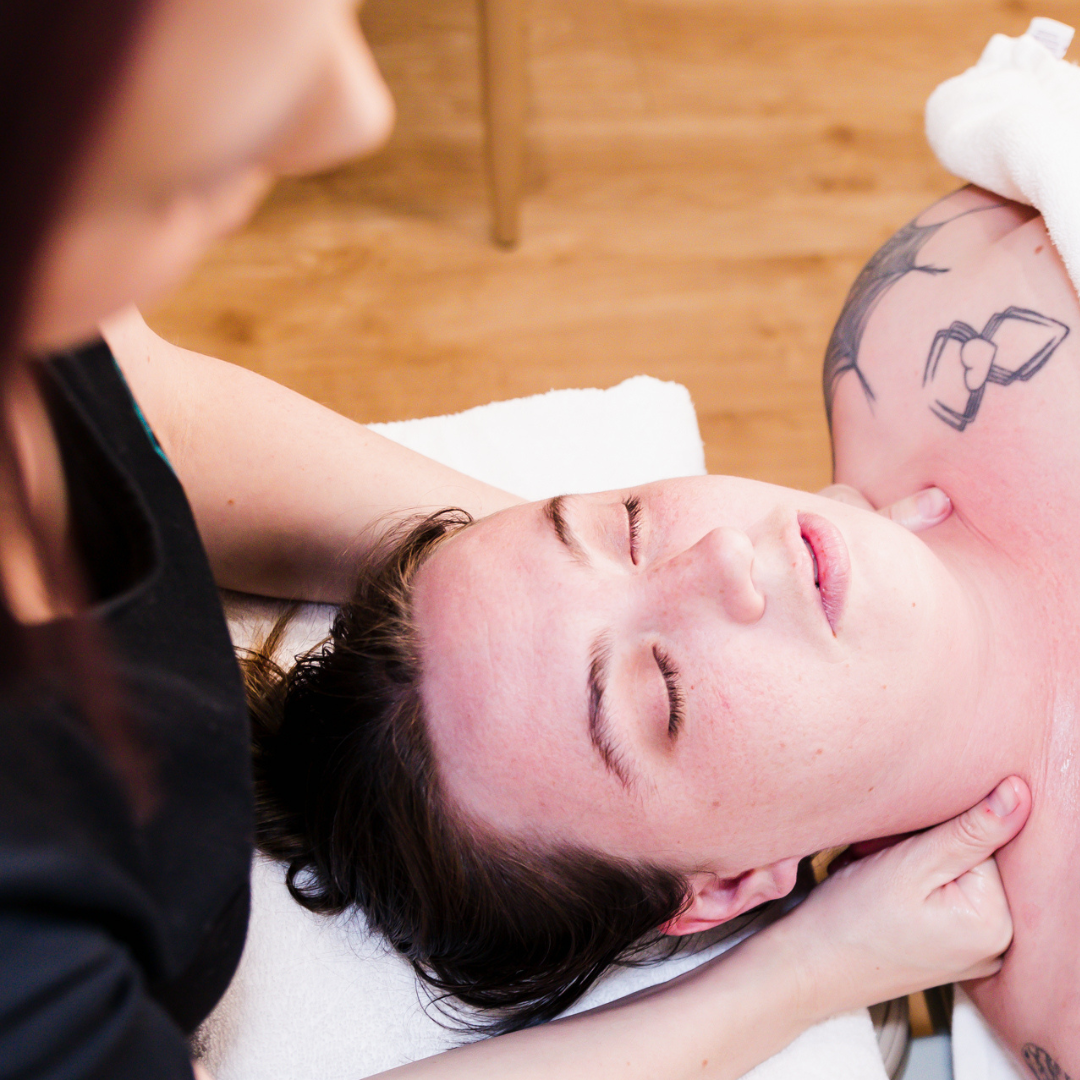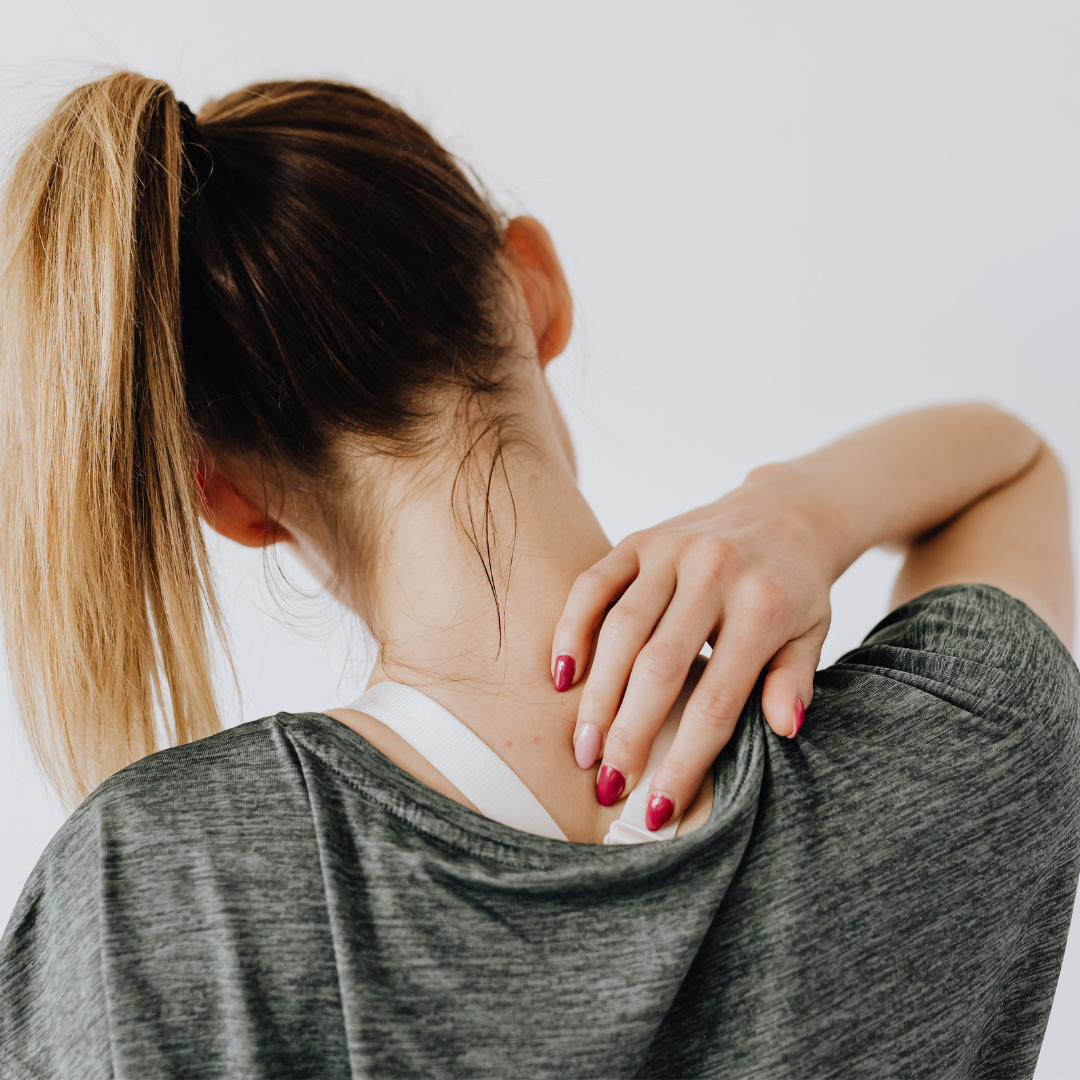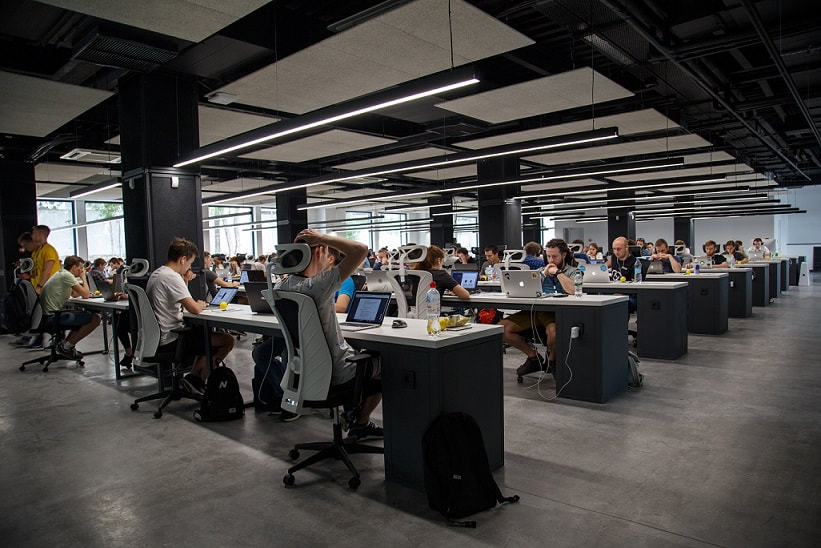|
By Megan Cornish, Myotherapist Over the last week in particular there has been an increase in acute neck pain and cases of facet joint irritation. In this blog we will discuss the symptoms of an irritated facet joint and discuss available treatment options as well as some tips and tricks you can utilise at home. So, without further ado, let's dive into the wonderful world of facet joints! Have you ever woken up one morning with neck pain and stiffness that progresses quickly into very limited ability to move your neck and intense pain? Maybe you’ve found it difficult to head check to the left or to the right when driving in the car so you’ve had to use your whole body to turn to do so. Maybe you have been standing under the warm water of the shower for a while now or glued to your hot pack trying to get any form of relief from extremely stiff neck muscles. If you have or are currently experiencing any of the above scenarios you may have an irritated facet joint in your neck.
Facet joints are joints that connect the bones of your spine together allowing your spine to bend, twist and rotate. Whilst providing movement they also support the spine and prevent excess movement by providing structural support to the overall spinal column. These joints sit at the back of the spine and there are 4 facet joints for each vertebrae, 2 upper and 2 lower. Sometimes these joints can become inflamed due to certain conditions such as osteoarthritis, trauma from a car accident or sport injuries, or from more mundane daily activities like sleeping awkwardly or a rapid movement that twinges the neck. For the purpose of this blog we will be addressing neck related facet joint pain however it is important to note that facet joints can get inflamed along any point of the spinal column. How do we know that your current neck pain is facet joint related? There will be a few different things that we look for to identify that the root cause is a facet joint. The biggest clue that we get is which movements of the neck are impacted. In facet joint presentations it may be painful to move/look to one side however almost completely fine/very minimal pain when looking the other way. For example you may be able to head check to the left with no issues but have difficulty head checking to the right. You may also be experiencing discomfort when looking at the ceiling however not when looking down at the ground. This is due to the space between the joints narrowing/ closing off in these same side movements compared with the other side. Facet joints will usually affect one side and pain will often be one sided/ local to the region. Another big clue is your description of the type of pain you are experiencing. Patients will often describe their pain as a locking, jamming, pinching, tightness/stiffness or achy sensation. As Myotherapists we can assess your ability to move actively AND passively. Which means we will watch you do the movements first, but if that doesn’t confirm our suspicions we can then do the movements for you by getting you to lie down on your back and (try your best to) let us control your movements. When we do this we are taking the muscles out of the equation and all that's left is your joints, if you still experience pain while we do the movements for you this is most likely a facet joint. We will also palpate (feel/press on) the joints to check for tenderness at the joint itself, there are also a couple special orthopaedic tests that we can use to confirm that we are dealing with a facet joint. If all of that comes up positive for a facet joint pathology as well as the correct symptom profile for a facet joint pathology, then we have found the culprit of your pain! One of the main reasons facet joints are so painful is the muscular guarding that comes with the condition. The main thing to remember here is that the body is very VERY good at protecting itself when something isn’t quite right. Therefore if your joint gets inflamed your nervous system is going to send messages to all of the surrounding muscles to “guard” and protect the injury as best as possible. This is what causes the really tight muscles and very limited range/ability to move your neck. Another important thing to note is that your body will absolutely heal itself! Facet joints usually tend to be acutely painful for anywhere from 2-7 days, but usually do not hang around longer than 2 weeks. We call this a self limiting condition, which means it typically will resolve itself even without any intervention - however, most people like to speed up the process by getting it treated. Myotherapy is a great way to support the natural healing process and speed up your overall recovery from this condition. As Myotherapists we are trained in being able to safely treat joint pathologies and facet joint irritation as part of our scope of practice. This means that along with treating the muscular component we can also use techniques such as joint mobilisations and joint MET to promote healthy joint function and healing. Not sure what a joint mobilisation is? Its a slow, low grade movement that we use to allow an irritated joint to begin moving freely again. Its not a “Crack!” of your neck!! The “cracking” technique is called a Manipulation or Adjustment, which is a full force, high velocity movement that only a qualified chiropractor or osteopath is able to provide for you, if that is more your style. Facet joints also tend to respond well to dry needling on the affected side. We can needle the super tight muscles that are locking up around the joint to restore freedom of movement. This can help make the healing process quicker, and reduce the intensity of the pain while your facet joint recovers. In terms of home care for facet joints here are some things we like to suggest patients with a joint irritation do at home:
This exercise can be done by making a double chin! (We know, super flattering!) Keep your eyes on a fixed structure at eye level in front of you and pull your head back to create that double chin. Be careful not to drop your chin to your chest or have your head tilted upwards, we want that nice neutral position and a slide back to execute this exercise efficiently.
The above suggestions are just some of the things you can do at home to aid the recovery of an inflamed facet joint in the neck; however it is most beneficial to the healing process to be doing these in conjunction with physical therapy to get the best results. Myotherapy is a great form of physical therapy and we treat these cases and presentations frequently. Its important to know that while this kind of pain can feel really horrible in its most acute stage, it usually won’t last longer than a few weeks, and likely even less if you get it treated very early on. If you have any of these classic facet joint irritation symptoms don't hesitate to book an appointment and together we will create a treatment plan to get you and your facet joints healthy and happy again! By Duke Autret, Myotherapist If your doctor has diagnosed you with Thoracic Outlet Syndrome (TOS), you may be wondering what to do next to treat the pain, numbness or tingling in your neck, shoulder or arm. Lets first look at what this condition is, in easy to understand terms. We'll also look at another condition called Scapulocostal Syndrome that shares similar symptoms. Then we will look at the ways a Myotherapist can help you with the neck, shoulder, arm or hand symptoms you're experiencing, whether its from Thoracic Outlet Syndrome or Scapulocostal Syndrome. What is TOS?
Thoracic Outlet Syndrome is a condition characterised by compression of the nerves and blood vessels in the thoracic outlet area, located between the collarbone and the first rib. This compression can lead to a variety of symptoms, including pain, numbness, and tingling in the neck, shoulder, arm, and hand. Causes & Symptoms of Thoracic Outlet Syndrome TOS can be caused by a combination of factors, including:
Common symptoms of TOS include:
Scapulocostal Syndrome is a Related Condition Scapulocostal Syndrome, also known as snapping scapula syndrome, shares similarities with TOS. It involves excess tension, trigger points, irritation or inflammation of the soft tissues between the scapula (shoulder blade) and the ribs, resulting in pain behind the shoulder blade and upper back with sometimes audible or palpable snapping or clicking sensations during shoulder movement. Commonalities Between TOS and Scapulocostal Syndrome
Myotherapy Interventions for TOS and Scapulocostal Syndrome: Targeted Manual Techniques
Thoracic Outlet Syndrome and Scapulocostal Syndrome can significantly impact daily life, causing pain and discomfort in the neck, shoulder, arm, and hand. Myotherapy offers tailored interventions to address the underlying muscle imbalances, reduce compression, and alleviate symptoms associated with these conditions. If you're experiencing symptoms of TOS or scapulocostal syndrome or you've been given the diagnosis by your GP, consulting a qualified myotherapist is the first step towards finding relief and improving your overall well-being. Take proactive steps towards a pain-free life today and book a time with a great Myotherapist here at Simple Wellness Myotherapy. By Jacqui Mulholland, Remedial Massage Therapist You might have heard of this relatively new slang term called “tech neck” which is becoming more and more common to see in the media. Tech Neck refers to a group of symptoms characterised by neck tightness and tension caused by chronic overuse of the neck muscles that are working overtime to keep your head upright. Neck, shoulder and upper back tension and pain are some of the most common issues that our team treat every day, so if you're experiencing this pain, you're not alone, and there are plenty of ways we can help bring relief to your symptoms. What are the symptoms?
You could be experiencing Tech Neck if you have noticed some of the following symptoms;
If you have any of these symptoms and are using a screen regularly, this can be one possible cause for the discomfort you are experiencing. Tech has become an essential part of our daily lives and whether we like it or not, it’s here to stay. So we need to understand what this is doing to our body’s and how we can help prevent long term damage and support a healthier spine. The human head weighs about 5kgs, and all of that weight is being supported by our postural muscles of the neck, chest and upper back. The neck muscles are supporting most of that weight. When you are looking down at your screen, these neck muscles engage to stabilise your head for you. Being in this forward flexed position for prolonged periods of time just adds to the amount of stress being placed onto these muscles and eventually, they will become tired, tight and sore. Overtime, without treatment this can lead to more complex neck, upper back and shoulder conditions affecting mobility, functioning and quality of life. It can also lead to fatigue, poor concentration, sleep disturbance, frustration and reduced productivity. Fortunately before it gets to this stage you have a really effective, accessible and non-invasive treatment method to manage these symptoms naturally. Massage and Myotherapy work to free up and loosen these affected neck muscles. Regular treatments help to prevent ongoing issues arising as a result of overuse of screens. Our therapists will also advise you on easy, affordable and time-wise prevention strategies you can use at home in between treatments to alleviate your pain and increase the effectiveness of our treatments. Prevention What can you do at home to help prevent Tech Neck becoming an issue for you?
Keeping up with some of these simple preventative measures at home can help reduce the frequency of and intensity of your symptoms. If you are unsure whether your symptoms are as a result of Tech Neck or some other condition, it is always best to visit your primary health care provider to eliminate other potential causes. With some regular Massage and Myotherapy treatments, Tech Neck can be well managed and we can give you some specific advice including home care & exercises to maintain the health and integrity of your neck muscles. Make a booking with one of us at Simple Wellness and we will assess your symptoms and provide a customised treatment plan to get you the best results for your Tech Neck. If you've ever had that one-sided sharp, catching pain in your neck or back that stops you moving even slightly towards that painful side, you've likely experienced a sprained facet joint. Facet joint sprains can be a source of intense back or neck pain, limiting our mobility and overall quality of life. This kind of injury is usually fairly short lived, but the first few days when its at its worst can be very highly sensitive and irritable. The acute phase usually doesn't last more than a week, and the pain usually subsides entirely within 2-3 weeks. These injuries can result from trauma (like a car accident), repetitive motions or rapid combination movements (like bending/twisting/lifting too quickly), or can be predisposed in degenerative conditions where the joint has been previously injured or where the joint isn't as healthy as it could be. Even though this condition is normally short-lived, it can be challenging to manage and exceptionally painful. Facet joints are small joints located at the back of the spine, connecting the vertebrae. When they are happy they provide stability and allow for easy non-painful movement in the spine. When these joints become injured or strained, it can be a very painful experience. Turning your head to the impacted side is usually very restricted by a sharp, bony pain. Often turning to the opposite side is much easier and without the same sting of instant pain.
Common causes include sudden trauma or whiplash type injuries, quick repetitive motions, or lifting and twisting at the same time. We'll often hear people say "I slept funny and now I can't turn my neck that way", this can be from sleeping in a weird or awkward position with the neck jammed up overnight. Symptoms of facet joint sprains include localised pain which is usually one sided, stiffness, reduced range of motion due to intense pain, and muscle spasms. The muscles around the impacted facet joint can go into a protective spasm to prevent you from moving, but the spasm itself can be very painful and can cause referral of pain to other areas. If the sprained facet joint is in your neck, its common to get a headache referred from the surrounding muscles. If the sprained facet is in your back, the referral patterns from an upper back facet is usually to the shoulders, or from a lower back facet to your hips. These sprains can significantly impact daily activities, especially things that need you to be able to move easily and safely, like doing headchecks in the car, getting in and out of bed, or going to the gym. When it comes to facet joint sprains, our myotherapists offer several benefits: Pain Relief: Myotherapists utilise a range of techniques, including deep tissue massage, trigger point therapy, and joint mobilisation, to alleviate pain associated with facet joint sprains. By targeting the affected area and surrounding muscles, our myotherapists help reduce muscle tension, release endorphins, and improve blood circulation, resulting in pain relief. Techniques that can be used in acute stages include things like dry needling which can resolve muscle spasm without applying broad pressure over the area. Muscle Relaxation and Joint Mobility: Facet joint sprains often lead to muscle spasms and restricted joint mobility. Myotherapy techniques such as gentle stretching, soft tissue mobilisation, and joint mobilisation help relax the muscles, increase flexibility, and restore normal joint motion. These interventions promote healing, reduce inflammation, and enhance overall range of motion. Gentle mobilisations encourage the correct glide of the facet joints to return, and using techniques like Muscle Energy Technique we can often reduce the protective spasm and improve the amount of movement and the irritability of the joint fairly quickly. Muscle Imbalance: Musculoskeletal imbalances can contribute to facet joint sprains. Myotherapists assess and correct muscle imbalances through targeted exercises, ergonomic modifications, and postural retraining. By addressing these underlying issues, your myotherapist helps improve your alignment, reduce stress on the facet joints, and prevent further injury. Strength and Stability: Myotherapy focuses not only on treating the immediate pain but also on building strength and stability to prevent future sprains, once the pain intensity allows us to do so. Myotherapists develop customised exercise programs to strengthen the muscles supporting the spine, enhancing overall spinal stability and reducing the risk of recurrent facet joint sprains. For a facet joint sprain, we usually expect this part of your treatment plan to begin about 2 weeks into your program, once the pain has settled and you have regained mobility. Education and Self-Care: Myotherapists play an essential role in educating our patients about facet joint sprains and self-care techniques. We provide guidance on proper body mechanics, ergonomics, and exercises to maintain a healthy spine and prevent further injuries. Empowering individuals with the knowledge to take control of their own well-being is a fundamental aspect of myotherapy. Facet joint sprains can significantly impact our daily lives, causing pain and limiting our mobility. Myotherapy offers a comprehensive approach to treating facet joint sprains by addressing pain, muscle tension, joint mobility, and underlying imbalances. Through techniques such as pain relief, muscle relaxation, joint movement correction, and strength training, myotherapy aims to provide lasting relief and prevent future sprains. If you're struggling with facet joint sprains, seeking the expertise of our qualified myotherapists can be a valuable step towards finding relief and regaining functionality. Book online with any of our great Myos, or call us on 03 8204 0970 for more information. If you work at a desk for hours on end, you know that it can be uncomfortable at the best of times. Office workers have just as much risk of injury and chronic pain as other more physically strenuous occupations. You may be at risk of issues including back pain, neck pain, repetitive strain injury or RSI and carpal tunnel syndrome.
So how can you minimise your chance of hurting yourself and stay at the top of your game? Our myotherapist Emily shares some of her tips for staying healthy and preventing pain and injury for office workers. Stretch often When you’re focused on your work, you often forget to shift position. Unfortunately, our bodies weren’t designed to stay in a position for hours at a time. That’s why the simplest tip is to stretch whenever you feel stiff, sore or fatigued. Stretching can also help to boost blood flow to the brain, which means you are more focused and productive. You can simply stretch at your desk if needed – stretch out your neck, shoulders and back, and do some circles with your ankles. But you can also do a standing stretch, which brings us to our next tip. Set yourself reminders to move Small amounts of movement throughout the day add up when it comes to preventing office injuries. But when you’re in the zone, you might forget! That’s why it’s useful to set yourself a reminder or alarm on your phone or computer. Aim for at least 1-2 minutes per hour of movement. This might be standing and stretching, going and getting a glass of water, making yourself a coffee or tea, going to the toilet or just walking around the office to get your muscles and joints moving. Give a sit/stand desk a try Desks that can alternate between a seated and standing position have become popular recently. They allow you the best of both worlds – you can sit for a bit, then switch to standing as a break from sitting. Have a chat to your employer about whether you can trial a sit-stand desk. The good thing is that many people find sit-stand desks boost productivity, so employers are often open to them. If you work for yourself or you are the boss, you can hire sit-stand desks and other equipment before purchasing. Make the most of lunchtime It can be tempting to eat lunch at your desk and power through the to-dos. But your lunch and break times are an opportunity to move around and give your muscles and joints a break as well. Get up and get moving. Head to a local park to have your lunch if it’s sunny outside. Grab a coffee from the café around the corner. You can even go for a brisk 5-minute walk around the block at the end of your break to wake up your brain and your body. That way, you’ll go back to work feeling refreshed. Get moving before or after work Some days you won’t get much time to move at work, so make the most of the hours outside of work. Find a way to get your body moving on a regular basis. This doesn’t mean you need to slog away at the gym for an hour every day. You can do some yoga stretches at home, walk the dog or go to the playground with your kids. If you do find yourself too tired to move after work, try getting up 15 minutes earlier and go for a walk around the block before work. It seems counter-intuitive, but exercise actually boosts your energy and relieves fatigue. Even a little bit each day will add up! Get a regular remedial massage or myotherapy treatment Your muscles and joints need care, just like every other part of you. That’s why regular treatments can help to prevent injury and pain. Our desk worker clients find that a treatment every 2-6 weeks helps to relieve tension and pain. Many report that they have fewer headaches, lower stress levels, improved sleep and mood and greater movement in joints and muscles. So if any of those are on your wish list, regular massage and myotherapy might be the answer! Is regular massage or myotherapy on your to-do list? Our myotherapist Emily is currently open for new clients. You can book with a session with her here. Headaches can vary from mildly dull and annoying to intensely sharp or throbbing. They can creep in slowly, or seem to appear out of nowhere. For some people they can last for a very short time, and others get headaches that just don't seem to quit. No matter what the cause of your headache, these simple tips are a great first step to help you to feel a little bit better. Suss out the origin
First up, you want to figure out why you have a headache. Have you spent too long at the computer without moving over the last few days? Have you been under a lot of stress? Have you lifted or carried something heavier than you're used to? Are you dehydrated? Or could it be hormone related? Having an idea of why you have a headache can help you figure out if you need help from your Myotherapist for muscle related pains, or if you need to make some changes to your routine like drinking more water or finding ways to reduce stress. Check in with your muscles Most headaches have some kind of muscular involvement, whether it’s directly causing the headache or is a side effect of the pain. The good news is that you can figure out if your muscles are involved. Have a feel along your neck and shoulders for any trigger points – spots that are tender and a bit painful to touch. Strong trigger points can send referred pain to other muscles, too. These are signs that your muscles are feeling tense, maybe from more physical activity than you're used to, or from staying in one position for a long time. Sometimes even your arms can have trigger points, so have a feel around your upper arm, particularly along the tricep area on the back of your arm. Have you been clenching your teeth? Feel around your face and jaw to check if there are any super-tender areas. You might also find a tight band around your temples. Headaches can be an early sign of TMJ dysfunction, so make sure you see your friendly myotherapist quick-smart if you are getting headaches caused by clenching or grinding. Are you getting sick? Another common cause of headache is sinus pain. Try gently pressing between your eyebrows and on either side of your nose, right below the eyes. If this area is tender, you might have a case of sinusitis coming on, and you'll probably have other symptoms like a runny or blocked nose and a fever. If you have a cold or infection, its always best for both of us if you wait til you've recovered from the contagious phase of the infection before you come in to see me. Check in with your pharmacist for a recommendation for something that can help with your cold/flu or infection symptoms - clearing the infection can often clear the headache! Something I can vouch for personally is Salt Therapy to speed up the time it takes for a sinus infection to clear. The salt helps with inflammation in the nose and lungs, as well as breaking up the congestion and making it easier to clear the sinuses which hugely relieves the pressure. Natalie at Salts of the Earth in Boronia takes care of me when I feel a sinus infection or cold coming on. Have a good stretch Remember those muscles from the last tip? They are the ones we want to stretch out gently. Roll your neck up and down, then side to side, breathing into any tight or sore spots. My little bonus tip here is to sit on your hand or hold the base of your chair so that you can really isolate the stretch into your neck and shoulders - when you're super tight, sometimes what should be a neck stretch becomes the whole upper body moving at once! Locking down your shoulder by sitting on your hand will help you feel a much more satisfying stretch into your neck! Open and close your jaw slowly, stretching out the muscles and releasing tension. Using your fingertips to massage over your jaw while you open and close can also feel really relieving! Reach your arms back behind your body for a stretch that targets the front of your shoulders, then roll down slowly as if you were trying to touch your toes for a nice back stretch - it doesn't really matter if you can or can't actually get to your toes, its more the stretching action here that counts. You can even bend at the knees if you feel too much strain in your hamstrings and the back of your legs. Drink some water! Most of us don’t drink enough water – myself included. But dehydration can cause headaches, and make them worse even when it’s not a direct cause. If you feel a headache rolling in, drink 1-2 cups of water. It can’t hurt, so why not give it a try? Is stress playing into your headaches? What does your down time routine look like? If its a bit neglected, try to find some time for things that you enjoy that can help reduce stress. For some people, that could be exercise or meditation - which are both fantastic for getting your brain to release some lovely happy hormones and neurotransmitters! But it might also be reading, gardening, seeing a friend, going out for a meal, playing a game. Remember – headaches and migraines are two different things! A super-bad headache does suck, but it feels different to a migraine. I’ll be sharing more on migraines in the future, but there are a few telltale signs. It’s probably not a migraine unless you experience at least a few of these:
If you have a headache that is being caused or worsened by tight muscles, I’m here to help. A Myotherapy treatment for headaches will look at your head, jaw, neck and shoulders, and could include some feel-good remedial massage to release tight muscles, as well as other approaches like cupping, needling or mobilisations to reduce pain and improve your movement. Book in a short session today, and we’ll have you feeling better shortly. The human body is complex – pain isn’t always where we think it is. With referred pain, we feel pain in one spot, but the actual issue is somewhere else. One of the most common spots that can cause referred pain is the neck. Let’s have a look at why your neck might be the source of some of the pain you feel. Why the neck impacts so much
So why is the neck capable of causing referred pain? A lot of what it comes down to is that the neck is part of the spine, which is where most of the central nervous system is situated. The CNS is made up of the spine and brain, and is where all of the pain we experience is processed – whether it’s muscular or nerve related. This area is particularly vulnerable to degeneration and damage to the vertebrae that protect the spine. This sort of damage can lead to nerve impingement and inflammation that triggers the nerve. That then can lead to pain being experienced anywhere along the length of that nerve. However, there is also the lifestyle impact on the neck. Check in right now – how are you holding your neck? Chances are, you’re hunched over your phone, or slumped in front of a computer. And that can lead to muscle strain around the neck area. Because the muscles around the neck connect to many other major muscle groups of the body, it can lead to other muscles hurting due to overcompensation. These are just a few of the reasons why your neck might be the origin of your pain. Pains that might be neck related You might be feeling pain. But what sorts of pains can be related to problems in the neck? Common issues might include: · Headaches · Migraines · Shoulder pain · Arm pain · Upper back pain · Mid back pain · Full length back pain · Chest pain (muscular) Simple neck stretches to try Sometimes, the neck just needs a little bit of TLC to feel better. For some gentle relief, try these simple neck stretches when you’re feeling sore. · Move your head up and down slowly. Move up until you feel a gentle stretch, and then down until you feel a stretch. Go a little bit further each time as your muscles stretch out and relax. · Move your head from side to side, with your ear coming down towards your shoulder. Again, move to one side until you feel a gentle stretch, and then to the other until stretching. No cheating - make the movement come from your neck, not from your shoulder raising upwards. · Gently circle your head. Alternate between clockwise and counter-clockwise. If one spot feels good to stretch – pause for a few moments at that spot, then continue. Neck pain – wherever it ends up – doesn’t disappear overnight. If you have ongoing neck problems, your best bet is a treatment plan personalised to your body’s needs. Book in your initial appointment today, and we can get you back on track to feeling great. |
Meet Our Team
We have a team of great practitioners available 7 days a week at our Rowville clinic. Archives
July 2024
Categories
All
|
Got a question about Myotherapy?
Contact Mel by phone, email or Facebook
|
Simple Wellness Myotherapy & Remedial Massage Clinic
Shop 12B 150 Kelletts Rd Rowville VIC 3178 |
Phone us on
03 8204 0970 |








 RSS Feed
RSS Feed